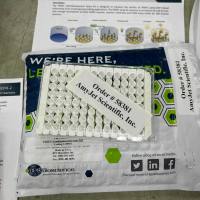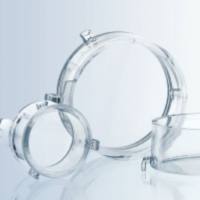【共享】Highly Efficient Ligation for Large Inserts
丁香园论坛
583
我从网上看到的,与大家分享。点此下载
Highly Efficient Ligation for Large Inserts
One of the major problems with the success of ligation reactions, and thus the cloning experiment as a whole, is ensuring the restriction digests are complete and the dephosphorylation of the vector termini was successful. This procedure also identifies problems with dephosphorylation or the substrate having unligateable ends. This procedure will be successful whether the insert has been left with dissimilar termini (i.e. BamHI/NotI fragment), as well as similar termini (i.e., BamHI sites on both ends of fragment).
1.) Digest insert and vector DNA to total completion with restriction enzyme. Gel purify, and “quantitate” using the BRL high-mass ladder. SpeedVac DNA and suspend in a minimal volume as starting material for the ligation (I use 10ul).
a. I used 5ug of 5kb insert DNA in a sequential NheI/NotI digest, even though these enzymes are (wrongly) supposed to get along well in NEBuffer 2. I used 3ul of 10U/ul enzyme in a 50 rxn, and the reactions were only complete after 3 hr/each!
2.) Dephosphorylate vector at 37C with Antarctic Phosphatase, using 1ul enzyme/ug DNA. Go 20′ for 5′ overhangs or blunt ends, 1 hr. for 3′ or blunt overhangs.
3.) Titrate ligase against insert. Make serial 5X dilutions of T4 DNA ligase in 1X ligation buffer (keep on ice). Set up 5 or 6 of these.
a. Take 50ng of insert DNA, and ligate in a 10 reaction with 1ul of the serially-diluted ligase for 15′ at room temp. Use the NEB quick ligation kit (buffer contains PEG). Use one tube with 1ul of straight-up ligase right out of the tube.
b. Stop reaction by adding 1ul 0.5M EDTA, and run the reactions on a gel.
Highly Efficient Ligation for Large Inserts
One of the major problems with the success of ligation reactions, and thus the cloning experiment as a whole, is ensuring the restriction digests are complete and the dephosphorylation of the vector termini was successful. This procedure also identifies problems with dephosphorylation or the substrate having unligateable ends. This procedure will be successful whether the insert has been left with dissimilar termini (i.e. BamHI/NotI fragment), as well as similar termini (i.e., BamHI sites on both ends of fragment).
1.) Digest insert and vector DNA to total completion with restriction enzyme. Gel purify, and “quantitate” using the BRL high-mass ladder. SpeedVac DNA and suspend in a minimal volume as starting material for the ligation (I use 10ul).
a. I used 5ug of 5kb insert DNA in a sequential NheI/NotI digest, even though these enzymes are (wrongly) supposed to get along well in NEBuffer 2. I used 3ul of 10U/ul enzyme in a 50 rxn, and the reactions were only complete after 3 hr/each!
2.) Dephosphorylate vector at 37C with Antarctic Phosphatase, using 1ul enzyme/ug DNA. Go 20′ for 5′ overhangs or blunt ends, 1 hr. for 3′ or blunt overhangs.
3.) Titrate ligase against insert. Make serial 5X dilutions of T4 DNA ligase in 1X ligation buffer (keep on ice). Set up 5 or 6 of these.
a. Take 50ng of insert DNA, and ligate in a 10 reaction with 1ul of the serially-diluted ligase for 15′ at room temp. Use the NEB quick ligation kit (buffer contains PEG). Use one tube with 1ul of straight-up ligase right out of the tube.
b. Stop reaction by adding 1ul 0.5M EDTA, and run the reactions on a gel.







